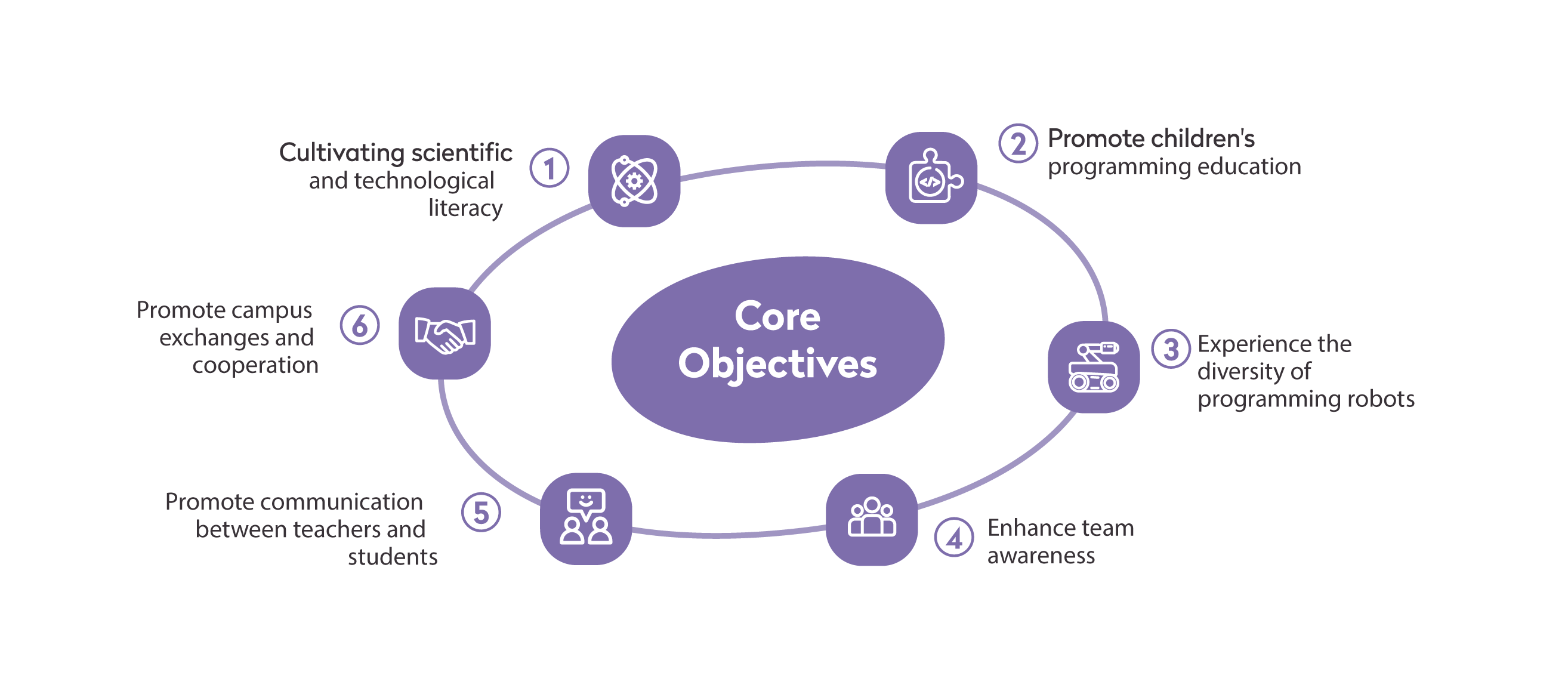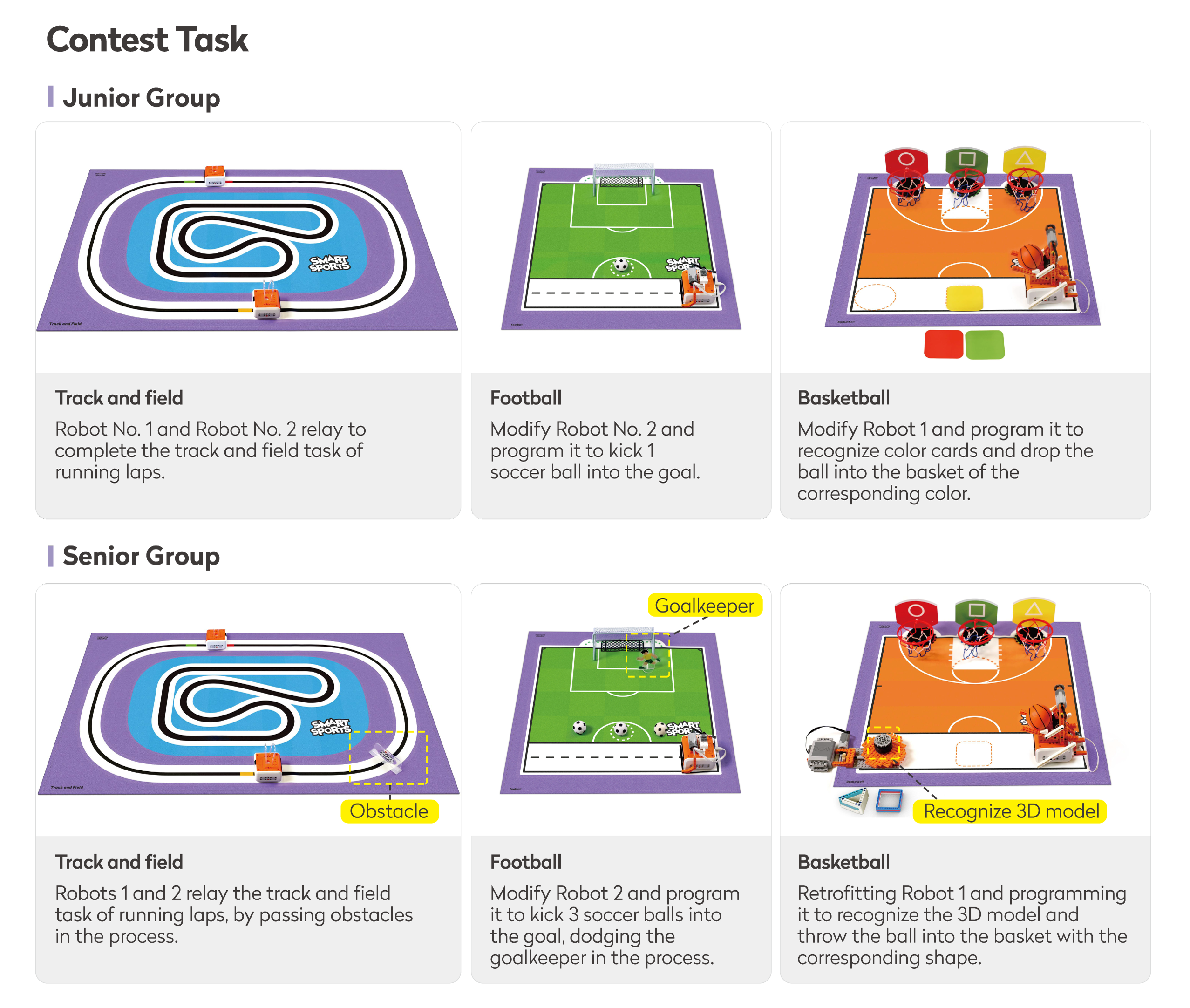- Smart Sports
- Little Energy Hunter
- Rainforest Adventure
Competition Groups
- Junior group (ages 8-11)
- Senior group (ages 12-14)
-
- Number of contestants: 2 people per team
- Advising instructors: 1 (not required).
- Each person can only participate in one team
- Each team needs to have 2 robots, computers or tablets
VENUE:
- TBA
PRIZES
- TBA
COMPETITION TIMELINE
- 29th July
MatataStudio Smart Sports Competition
Smart Sports Competition is designed to train children’s logical thinking skills, programming skills and teamwork skills.
With the theme of “scientific and technological innovation and sports competition”, the competition cultivates children’s programming logic thinking in STEAM game scene competitions and improves children’s comprehensive scientific literacy through track and field obstacle races, basketball games, football games and other competition tasks.

- Coding system: Coding software that can complete the competition tasks.
- Coding computer: Contestants bring their own laptop or iPad to use in the competition and ensure that the battery is charged enough for the competition. (They may bring portable charging devices.)
- Prohibited devices: USB drives, CDs, wireless routers, cell phones, cameras, remote controls, and other devices with memory or communication capabilities.
- Competition field:


Little Energy Hunter Robotics Competition
“Little Energy Hunter” is a game-based MatataWorld Robotics Competition designed to develop children’s skills in logical thinking, coding, and teamwork. Participants progress through various game levels to obtain competition spirit treasures, allowing them to understand the MWRC competition spirit.
The MatataWorld Robotics Competition is an annual grand event held on Planet Matata. The energy of the competition spirit, symbolizing the competition’s highest honor, has been stolen and scattered across Planet Matata due to improper storage. To recover this energy, participating teams embark on a thrilling and mysterious treasure hunt.
Teams must progress through three stages: Activating Password, Collecting Energy, and Guarding Energy. The competition aims to cultivate children’s programming logic through gamified STEAM activities and improve their overall scientific literacy.
Team Requirements
- Team Composition: Each team consists of two robots, two participants, and 1-2 coaches. One coach can supervise multiple teams.
- Pre-Schoolers: Age: 4 to 6 years old. Each team must have at least one instructor over 18 years old.
- Elementary Schoolers: Age: 6 to 9 years old. Each team must have at least one instructor over 18 years old.
Robot Requirements
- Approved Robots: Only MatataBots and related expansion packs produced by Matatalab are allowed.
- Modifications are permitted only with materials specified by the Organizing Committee.
- Robot Size: Modified robot size must not exceed 150mm x 150mm. Height is not limited.
- Robot Weight: Modified robot weight must be ≤350g.
- Motor Calibration: Participants must calibrate the robot’s motor before the competition. No calibration time will be provided during the competition. Appeals regarding score impacts due to a robot’s placement angle or uncalibrated motor will not be accepted.
Rainforest Adventure Competition
The Rainforest Adventure Interest Race, organized by the MatataWorld Robotics Competition, aims to cultivate logical thinking, coding, and creative abilities in preschool children. This competition guides children through a series of tasks in a competitive format, allowing them to explore the spirit of adventure and master new knowledge and skills. Humanity grows stronger through exploration, and life becomes more beautiful through adventure.
The rainforest, known for its mystery and danger, is the world’s most resilient and stable ecosystem. It remains hot all year with plentiful rain and minimal seasonal variation. Biological succession is rapid, and it is home to over half of the world’s flora and fauna species. From ancient times, adventurers have faced untold dangers exploring the forest’s depths, seeking to understand it more deeply.
Participants complete three stages: Route Marking, Obstacle Clearing, and a Treasure Hunt. This competition trains children’s coding logic through STEAM activities and improves their overall scientific literacy.
Team Requirements
- Team Composition: This is an individual competition. Each team consists of 1 robot, 1 contestant, and 1 instructor. The same instructor can mentor multiple contestants.
- Age Requirements: Contestants must be 4-5 years old. Each team must have at least one instructor who is at least 18 years old.
Robot Requirements
- Approved Robots: Only Matatalab’s Tale-Bot Pro may be used, and only Tale-Bot Pro’s attachments may be used to modify the robot.
- Motor Calibration: Contestants must calibrate their robot motors before the competition. No calibration time will be provided during the competition. Appeals regarding issues related to robot placement angles or uncalibrated motors affecting the competition will not be accepted.